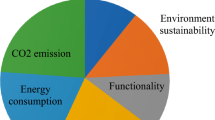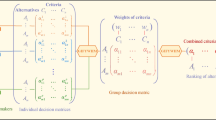Abstract
The 2-tuple linguistic model initiated by Herrera and Martinez has become one of the most useful computing with words approaches. It provides an effective way of representing the linguistic evaluation in terms of 2-tuples to avoid information loss in decision-making process. This research aims at extending the combinative distance based assessment (CODAS) method by virtue of 2-tuple linguistic Fermatean fuzzy Hamacher aggregation operators. We put forth several different types of 2-tuple linguistic Fermatean fuzzy aggregation operators, including the 2-tuple linguistic Fermatean fuzzy Hamacher weighted averaging operator, the 2-tuple linguistic Fermatean fuzzy Hamacher weighted geometric operator, the 2-tuple linguistic Fermatean fuzzy Hamacher Hybrid averaging operator, and the 2-tuple linguistic Fermatean fuzzy Hamacher Hybrid geometric operator. Some fundamental properties of the proposed 2-tuple linguistic Fermatean fuzzy aggregation operators are investigated. Furthermore, we develop a 2-tuple linguistic Fermatean fuzzy CODAS method with the proposed aggregation operators for solving multi-attribute group decision-making problems. Numerical examples regarding the selection of construction companies and McDonald’s franchisees are used to show the effectiveness of the proposed extended CODAS approach. Finally, a comparative analysis is conducted to validate the proposed approach and show its advantages.






Similar content being viewed by others
Data availability
The data that support the findings of this study are enclosed in this paper.
References
Adali EA, Tus A (2021) Hospital site selection with distance-based multi-criteria decision-making methods. Int J Health care Manage 14(2):534–544
Akram M, Ali G (2021) Group decision-making approach under multi \((Q, N)\)-soft multi granulation rough model. Granul Comput 6:339–357
Akram M, Martino A (2022) Multi-attribute group decision making based on \(T\)-spherical fuzzy soft rough average aggregation operators. Granul Comput. https://doi.org/10.1007/s41066-022-00319-0
Akram M, Shahzadi G, Ahmadini AAH (2020) Decision making framework for an effective sanitizer to reduce COVID-19 under Fermatean fuzzy environment. J Math. https://doi.org/10.1155/2020/3263407
Akram M, Naz S, Edalatpanah SA, Mehreen R (2021) Group decision-making framework under linguistic q-rung orthopair fuzzy Einstein models. Soft Comput 25(15):10309–10334
Akram M, Amjad U, Alcantud JCR, Santos GG (2022) Complex fermatean fuzzy N-soft sets: a new hybrid model with applications. J Ambient Intel Hum Comp. https://doi.org/10.1007/s12652-021-03629-4
Akram M, Ali G, Alcantud JCR, Riaz A (2022) Group decision-making with Fermatean fuzzy soft expert knowledge. Artif Intell Rev. https://doi.org/10.1007/s10462-021-10119-8
Akram M, Ramzan N, Feng F (2022) Extending COPRAS method with linguistic Fermatean fuzzy sets and Hamy mean operators. J Math. https://doi.org/10.1155/2022/8239263
Atanassov KT (1986) Intuitionistic fuzzy sets. Fuzzy Set Syst 20(1):87–96
Aydemir SB, Gunduz SY (2020) Fermatean fuzzy TOPSIS method with dombi aggregation operators and its application in multi-criteria decision making. J Intell Fuzzy Syst 39(1):851–869
Badi I, Ballem M, Shetwan A (2018) Site selection of desalination plant in Libya by using Combinative Distance-based Assessment (CODAS) Method. Int J Qual Res 12(3):609–623
Bolturk E (2018) Pythagorean fuzzy CODAS and its application to supplier selection in a manufacturing firm. J Enterp Inf Manag 31(4):550–564
Bolturk E, Kahraman C (2018) Interval-valued intuitionistic fuzzy CODAS method and its application to wave energy facility location selection problem. J Intell Fuzzy Syst 35(4):4865–4877
Chen SM (1998) Aggregating fuzzy opinions in the group decision-making environment. Cybern Syst 29(4):363–376
Chen SM, Chiou CH (2015) Multiattribute decision making based on interval-valued intuitionistic fuzzy sets PSO techniques and evidential reasoning methodology. IEEE Trans Fuzzy Syst 23(6):1905–1916
Chen SM, Chu YC (2020) Multiattribute decision making based on \(U\)-quadratic distribution of intervals and the transformed matrix in interval-valued intuitionistic fuzzy environments. Inf Sci 537:30–45
Chen SM, Hong JA (2014) Fuzzy multiple attributes group decision making based on ranking interval type-2 fuzzy sets and the TOPSIS method. IEEE T Syst Man Cy-S 44(12):1665–1673
Chen SM, Tsai BH (2015) Autocratic decision making using group recommendations based on intervals of linguistic terms and likelihood-based comparison relations. IEEE T Syst Man Cy-S 45(2):250–259
Dahooie JH, Vanaki AS, Mohammadi N (2020) Choosing the appropriate system for cloud computing implementation by using the interval-valued intuitionistic fuzzy CODAS multiattribute decision-making method (case study: faculty of new sciences and technologies of Tehran University). IEEE T Eng Manage 67(3):855–868
Deschrijver G, Cornelis C, Kerre EE (2004) On the representation of intuitionistic fuzzy t-norms and t-conorms. IEEE Trans Fuzzy Syst 12(1):45–61
Deveci Q, Cin R, Kagizman A (2020) A modified interval valued intuitionistic fuzzy CODAS method and its application to multi-criteria selection among renewable energy alternatives in Turkey. Appl Soft Comput 96:106660
Faizi S, Salabun W, Nawaz S, Rehman AU, Watrbski J (2021) Best-Worst method and Hamacher aggregation operations for intuitionistic 2-tuple linguistic sets. Expert Syst Appl 181:115088
Feng F, Fujita H, Ali MI, Yager RR, Liu XY (2019) Another view on generalized intuitionistic fuzzy soft sets and related multiattribute decision making methods. IEEE Trans Fuzzy Syst 27(3):474–488
Feng F, Xu ZS, Fujita H, Liang MQ (2020) Enhancing PROMETHEE method with intuitionistic fuzzy soft sets. Int J Intell Syst 35(7):1071–1104
Feng F, Zheng YJ, Sun BZ, Akram M (2022) Novel score functions of generalized orthopair fuzzy membership grades with application to multiple attribute decision making. Granul Comput 7(1):95–111
Garg H, Chen SM (2020) Multiattribute group decision making based on neutrality aggregation operators of \(q\)-rung orthopair fuzzy sets. Inf Sci 517:427–447
Garg H, Shahzadi G, Akram M (2020) Decision-making analysis based on Fermatean fuzzy Yager aggregation operators with application in COVID-19 testing facility. Math Probl Eng. https://doi.org/10.1155/2020/7279027
Hadi A, Khan W, Khan A (2021) A novel approach to MADM problems using Fermatean fuzzy Hamacher aggregation operators. Int J Intell Syst 36(7):3464–3499
Hamacher H (1978) Uber logische verknunpfungenn unssharfer Aussagen und deren Zugenhorige Bewertungsfunktione Trappl. Klir, Riccardi (Eds). Prog Cybern Syst 3:276–288
Herrera F, Martinez L (2000) A 2-tuple fuzzy linguistic representation model for computing with words. IEEE Trans Fuzzy Syst 8(6):746–752
Herrera F, Martinez L (2000) An approach for combining linguistic and numerical information based on the 2-tuple fuzzy linguistic representation model in decision-making. Int J Uncertain Fuzz 8(5):539–562
Herrera LTSF, Herrera-Viedma E (2000) Linguistic decision analysis: steps for solving decision problems under linguistic information. Fuzzy Set Syst 115(1):67–82
He TT, Zhang SQ, Wei GW, Wang R, Wu J, Wei C (2020) CODAS method for 2-tuple linguistic Pythagorean fuzzy multiple attribute group decision making and its application to financial management performance assessment. Technol Econ Dev Econ 26(4):920–932
Karagoz S, Deveci M, Simic V, Aydin N, Bolukbas U (2020) A novel intuitionistic fuzzy MCDM-based CODAS approach for locating an authorized dismantling center: A case study of Istanbul. Waste Manage Res 38(6):660–672
Keshavarz-Ghorabaee M, Zavadskas EK, Turskis Z, Antucheviciene J (2016) A new combinative distance-based assessment (CODAS) method for multi-criteria decision-making. Econ Comput Econ Cyb 50(3):25–44
Keshavarz-Ghorabaee M, Amiri M, Zavadskas EK, Hooshmand R, Antucheviciene J (2017) Fuzzy extension of the CODAS method for multicriteria market segment evaluation. J Bus Econ Manag 18(1):1–19
Kiraci K, Bakir M (2020) Evaluation of airlines performance using an integrated CRITIC and CODAS methodology: the case of star alliance member airlines. Stud Bus Econ 15(1):83–99
Martinez L, Herrera F (2012) An overview on the 2-tuple linguistic model for computing with words in decision making: extensions, applications and challenges. Inf Sci 207:1–18
Pamucar D, Deveci M, Gokasar I, Popovic M (2022) Fuzzy Hamacher WASPAS decision-making model for advantage prioritization of sustainable supply chain of electric ferry implementation in public transportation. Environ Dev Sustain 24(5):7138–7177
Panchal D, Chatterjee P, Shukla RK, Choudhury T, Tamosaitiene J (2017) Integrated fuzzy AHP-CODAS framework for maintenance decision in urea fertilizer industry. Econ Comput Econ Cyb 51(3):179–196
Roy J, Das S, Kar S, Pamucar D (2019) An extension of the CODAS approach using interval-valued intuitionistic fuzzy set for sustainable material selection in construction projects with incomplete weight information. Symmetry. https://doi.org/10.3390/sym11030393
Seker S (2020) A novel interval-valued intuitionistic trapezoidal fuzzy combinative distance-based assessment (CODAS) method. Soft Comput 24:2287–2300
Senapati T, Yager RR (2019) Fermatean fuzzy weighted averaging/geometric operators and its application in multi-criteria decision making methods. Eng Appl Artif Intel 85:112–121
Senapati T, Yager RR (2019) Some new operations over Fermatean fuzzy numbers and application of Fermatean fuzzy WPM in multiple criteria decision making. Informatica 30(2):391–412
Senapati T, Yager RR (2020) Fermatean fuzzy sets. J Amb Intel Hum Comp 11(2):663–674
Shahzadi G, Akram M (2021) Group decision-making for the selection of an antivirus mask under Fermatean fuzzy soft information. J Intell Fuzzy Syst 40(1):1401–1416
Silambarasan I (2020) New operators for Fermatean fuzzy sets. Ann Commun Math 3(2):116–131
Vinodh S, Wankhede VA (2021) Application of fuzzy DEMATEL and fuzzy CODAS for analysis of workforce attributes pertaining to industry: a case study. J Qual Reliab Manage 38(8):1695–1721
Wang H, Wang X, Wang LD (2019) Multicriteria decision-making based on archimedean bonferroni mean operators of hesitant Fermatean 2-tuple linguistic terms. Complexity. https://doi.org/10.1155/2019/5705907
Wei G, Lu M, Tang X, Wei Y (2018) Pythagorean hesitant fuzzy Hamacher aggregation operators and their application to multiple attribute decision making. Int J Intell Syst 33(6):1197–1233
Yager RR (2013a) Pythagorean fuzzy subsets. In: Joint IFSA World Congress and NAFIPS Annual Meeting (IFSA/NAFIPS), pp 57–61
Yager RR (2013b) Pythagorean membership grades in multicriteria decision making. IEEE Trans Fuzzy Syst 22(4):958–965
Yeni FB, Ozcelik G (2019) Interval-valued atanassov intuitionistic fuzzy CODAS method for multi criteria group decision making problems. Group Decis Negot 28(2):433–452
Zadeh LA (1965) Fuzzy sets. Inf Technol Control 8(3):338–353
Zadeh LA (1975) The concept of a linguistic variable and its application to approximate reasoning. Inf Sci 8(3):199–249
Acknowledgements
This work was partially supported by the National Natural Science Foundation of China [Grant No. 11301415], the Shaanxi Provincial Key Research and Development Program [Grant No. 2021SF-480], and the Natural Science Basic Research Plan in Shaanxi Province of China [Grant No. 2018JM1054].
Author information
Authors and Affiliations
Corresponding author
Ethics declarations
Conflict of interest
On behalf of all authors, the corresponding author states that there is no conflict of interest.
Ethical approval
This article does not contain any studies with human participants or animals performed by any of the authors.
Additional information
Publisher's Note
Springer Nature remains neutral with regard to jurisdictional claims in published maps and institutional affiliations.
Rights and permissions
Springer Nature or its licensor holds exclusive rights to this article under a publishing agreement with the author(s) or other rightsholder(s); author self-archiving of the accepted manuscript version of this article is solely governed by the terms of such publishing agreement and applicable law.
About this article
Cite this article
Akram, M., Niaz, Z. & Feng, F. Extended CODAS method for multi-attribute group decision-making based on 2-tuple linguistic Fermatean fuzzy Hamacher aggregation operators. Granul. Comput. 8, 441–466 (2023). https://doi.org/10.1007/s41066-022-00332-3
Received:
Accepted:
Published:
Issue Date:
DOI: https://doi.org/10.1007/s41066-022-00332-3




